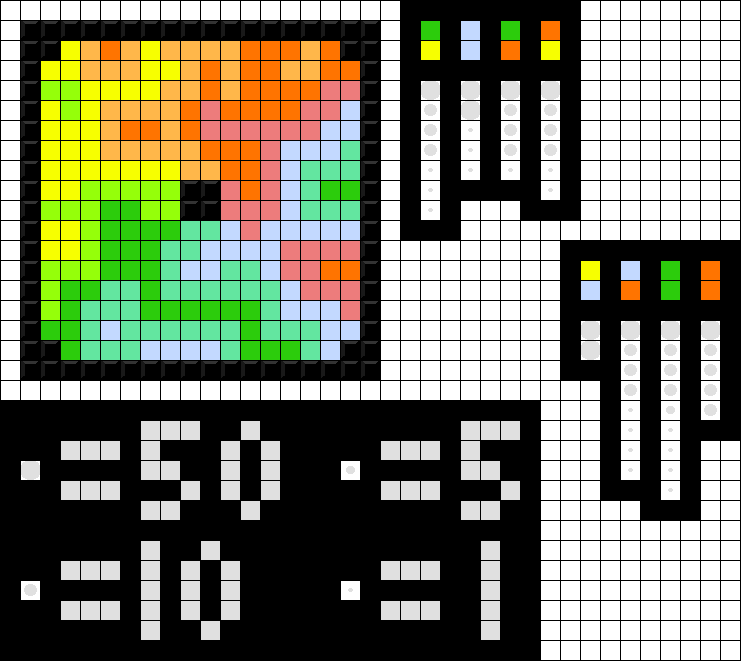1

 Vivaldi 0.2 "finished game" example w/ scoring
Vivaldi 0.2 "finished game" example w/ scoring
28 Dec 2018 05:02 by
project grantwood
"Gridpaint" version of the gameboard for "Vivaldi" (working title) as it might look after the conclusion of a game with 4 players.
The season assignments along the side show each player's public season (top) and private season (bottom). There are two sets of "possible" season distributions across four players.
Set 1:
Spring-Summer: 83 points
Winter-Winter: 103 points
Spring-Autumn: 81 points
Autumn-Summer: 82 points
Winter-Winter is the clear winner, with four separate regions (one of which is very large) and transition regions (dark pink and pastel green) that border many of Autumn's and Spring's regions. Of particular note is the area in the upper right quadrant where the dark pink "transition season" borders five of Autumn's separate regions--this transition region is worth 5 points with Winter as a public season and is worth 5 additional points with winter as a private season (there being 5 separate 1x1 spaces that border at least one completed region that's not Winter). Autumn, however, does not benefit nearly as much from its ownership of the same region of dark pink squares--with Autumn as public season, it's only worth one point (bordering one large Winter region) and as a private season, one point (with only a single 1x1 space bordering a completed region that's not Autumn).
Theoretically, such a large discrepancy could be due to the fact that the only player with Winter as a season has it for both their public and private season; however, it's also clear that Autumn was outplayed by Summer in a similar fashion (if we take the pastel orange regions in the upper left and upper right quadrants of the board into account, which feature a similar command of space that favors Summer by bordering Autumn's many small red-orange regions with a whopping 8 1x1 spaces not bordering a Summer region). Perhaps the Autumn-Summer player didn't realize that Winter-Winter had Winter as their private season, and imagined that sabotaging Autumn on the transition squares would be worth the resulting self-sabotage because of the greater gain in points it would provide to them, having Summer as their private season.
Set 2:
Summer-Winter: 100 points
Winter-Autumn: 84 points
Spring-Spring: 89 Points
Autumn-Autumn: 90 Points
Here, the winner is Summer-Winter, benefiting from the clear advantages on their transition squares bordering Autumn as mentioned in the analysis of set 1, as well as the strong tile coverage of Winter (34 squares in total). Ironically, Autumn-Autumn is in second place despite its weakness on transitional squares, here gaining more of points with Autumn as a public season through a large number of small regions (a full 16 points for 8 regions). However, Autumn's tile coverage is weak and has an unfavorable discrepancy with Winter (30/60 total tiles/points as opposed to 34/68 tiles/points), which limits Autumn's comparative potency as a private season scorer. With a few more tiles placed, however, Autumn-Autumn could have gained an advantage over Winter-Winter from set 1, despite being weak on its transition squares.
Spring-Spring is a strong third, with 31 tiles placed and good play on transitional squares bordering Summer in the upper and lower left quadrants. Its weakness is in its poor poor containment of Winter's two small regions around the lower left quadrant, with only two 1x1 spaces that don't border Spring, as well as its failure to pus the threat in the upper right quadrant against Winter via transition squares.
Bonus analysis:
A Winter-Spring or Spring-Winter player would be a phenomenal threat, here; Winter as a Public season scores 8 points for its 4 regions and 68 points as a private season for the number of tiles placed, in addition to 9 points as a public season for bordering nine different non-Winter regions on its transition squares and gaining 7 points as a private season for each 1x1 space that doesn't border a Winter region, meaning it would gain a public player 17 points and a private player 75 points. Spring is likewise strong, with 3 regions giving a public player 6 points and public transitions gaining 9 points for a public total of 15, and a tile spread of 31 giving a private player 62 points with 12 1x1 transition spaces that don't border a Spring region, giving a total of 74 points. Either way, 17+74 for Winter-Spring and 15+75 for Spring-Winter puts these players firmly in the low 90s. Winter-Winter is still strongest; nothing can beat that tile spread! In a real game, a Winter-Winter player would likely have significantly more trouble getting tiles placed if no other player had Winter as a season, making set 1 an unlikely combination for this particular "finished" board.
Wowzers. Who fed me coffee today? I'll stop here :)